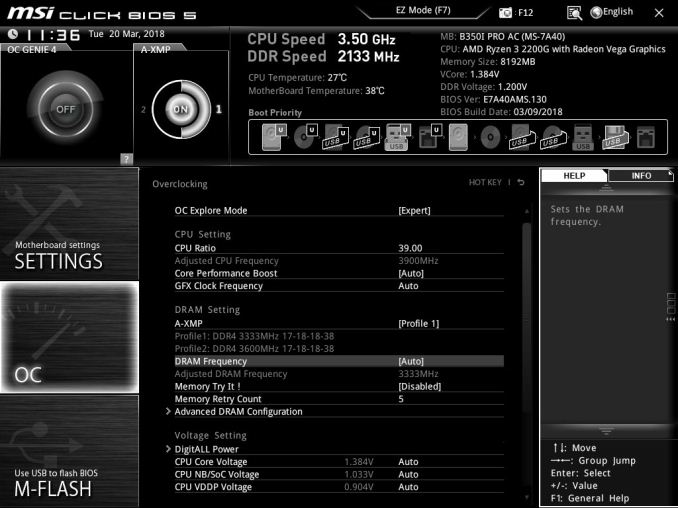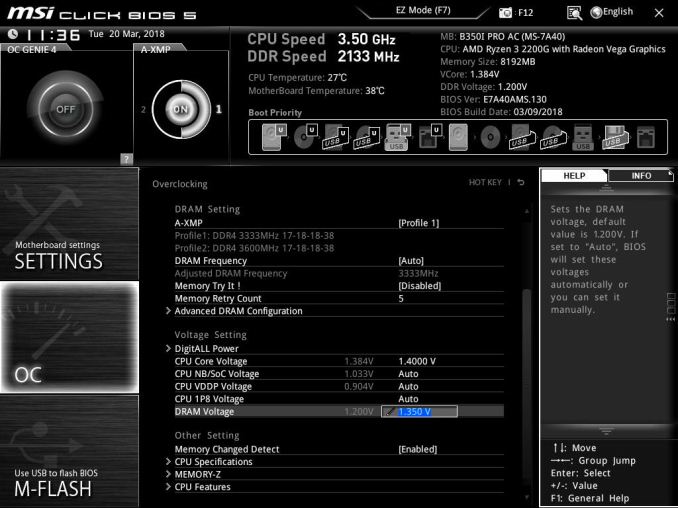AMD Ryzen 5 2400G and Ryzen 3 2200G Integrated Graphics Frequency Scaling
by Gavin Bonshor on September 28, 2018 12:30 PM EST- Posted in
- CPUs
- AMD
- GPUs
- Overclocking
- Zen
- APU
- Vega
- Ryzen
- Ryzen 3 2200G
- Ryzen 5 2400G
Overclocking Ryzen APU Integrated Graphics
As we detailed in our dedicated AMD Ryzen 2000 series APU overclocking guide and analysis, both the Ryzen 5 2400G and the Ryzen 3 2200G chips benefit from overclocking the CPU core frequency. The results on heavy computational workloads gave noticeable improvements across the board, while the gaming results didn't seem to have the expected 'oomph' so to speak. When it comes to overclocking the integrated graphics, the key directive and conclusion is that when a user is overclocking the CPU core frequency, it lessens the headroom available to overclock the integrated graphics and visa versa. It is a real push and pull situation.
Overclocking the integrated graphics on the MSI B350I Pro AC motherboard was quite easy as there are three main variables to consider.
- The graphics clock frequency is the primary frequency setting, measured in MHz
- The SoC voltage (or CPU NB Voltage) is directly linked to the integrated graphics voltage.
- The CPU core frequency and CPU core voltage can also help/hinder.
Beware the Black Hole!
When overclocking the integrated graphics core on both APUs, rising through the frequencies, we experienced an anomaly or 'black hole' between 1350 and 1500 MHz. Regardless of the settings, there was a clear issue in the system.
While the system would boot at these frequencies, the combination of overclock and drivers caused random reboots of the test system, constant and consistent crashes during gaming, and Windows Crash Reporter stating a 'Video_TDR_Failure' of the atikmpag.sys process. This error is usually an indication of a faulty or corrupt graphics driver, but in this instance, it happened across multiple systems with three different motherboards and operating systems using the AMD's Adrenalin Edition 18.5.1 WHQL drivers (the latest at the time of testing). The issue bestowed itself regardless of the GPU driver used, or BIOS revision on any of the motherboards tested.
At 1500 MHz however, the issue went away. Our experience is not unique - other professionals in the industry have experienced similar issues. We have reached out to AMD about this issue and will update when an official response is received.
Overclocking Results
The Ryzen 5 2400G has a base graphics frequency of 1250 MHz and the Ryzen 3 2200G has a base frequency of 1100 MHz. We were able to push both of them up to 1600 MHz, giving a 28% and 45% overclock respectively. For the completeness of data, we ran both APUs from 1100 MHz up to 1600 MHz, missing out the black hole. Here were our settings:
| Integrated Graphics Frequency | SoC/iGPU GFX Voltage |
| 1100 MHz | 1.15 V |
| 1150 MHz | 1.15 V |
| 1200 MHz | 1.15 V |
| 1250 MHz | 1.15 V |
| 1300 MHz | 1.15 V |
| 1350 MHz | 1.15 V |
| 1400 MHz | ERROR |
| 1450 MHz | ERROR |
| 1500 MHz | 1.20 V |
| 1550 MHz | 1.25 V |
| 1600 MHz | 1.25 V |












49 Comments
View All Comments
Lolimaster - Saturday, September 29, 2018 - link
There was an issue on the APU's were at certain frequencies the clock rate would jump around giving you nasty minimun (shown on many early reviews) and then after a certain threshold, the clock will not jump around like crazy, consistently beating the GT1030 at almost any scenario.ipkh - Friday, September 28, 2018 - link
So how about a Memory plus GPU overclock since those 2 combined would make the most difference.lightningz71 - Saturday, September 29, 2018 - link
Buildazoid showed that significant overclock on both the iGPU and the RAM was quite difficult. The iGPU reacted negatively to lower SOC voltage whereas the memory controller disliked higher SOC voltages. The happy medium seemed to be an iGPU at 1600mhz and running the ram at 3200-3400 mhz with the tightest possible timings. Leave the CPU cores at stock to maximize package power and thermal budget for the iGPU.The_Assimilator - Friday, September 28, 2018 - link
Anyone who knows discrete Vega knows it runs hungry and hot at stock frequencies and even worse when overclocked, but is far better behaved when underclocked and/or undervolted. Hence why these Vega iGPUs have so much OC headroom: they're deliberately being run slow in order to hit an acceptable power/heat target.Given that, the omission of power usage and temperature data from this review is glaring, to say the least.
jensend - Saturday, September 29, 2018 - link
I agree that 'overclocking scaling' reviews that don't show how power and temperature scale are failures. I wouldn't overclock the 2400G for tiny gains and large power/temperature/etc drawbacks.The one interesting conclusion that can be drawn from this piece is that the 2400G's shader etc performance at stock is high enough that at 1080p the bottlenecks are generally elsewhere (esp memory), while that's not as true of the 2200G. (We already kind of knew that from the memory scaling article.)
Nagorak - Saturday, September 29, 2018 - link
I agree, just posted the same myself.Lolimaster - Saturday, September 29, 2018 - link
Still the best reviewer for APU's, specailly OCing scaling and different resolution is techepiphany on youtube, shame on anandtech, they can't even do a proper review for an APU, just a lazy thing.Nagorak - Saturday, September 29, 2018 - link
I kind of feel like this is incomplete without some comparison of power use and heat generation. Maybe not at every frequency but it would be nice to see stock vs max OC at least. Based on the results with Vega GPUs it seems likely that efficiency craters as you go higher. It would be nice to know at least.neblogai - Saturday, September 29, 2018 - link
~50W higher power use is usually not an issue if total system power use is ~150W. But it would be useful to look at it from the point of motherboard SOC VRM ability. Raven Ridge chips are a budget option, so are usually used with cheaper B350 motherboards; however, those often do not have good SOC VRMs(and radiator on them) for extra power overclocked Vega iGPU consumes.notashill - Saturday, September 29, 2018 - link
The other big practical concern for budget builds is the need to spend more money on cooling. The cooler used in this review costs more than the 2400G so it would be totally nonsensical to actually use. Do they actually need crazy cooling to hit these overclocks, or is something like a $30 212 EVO enough?